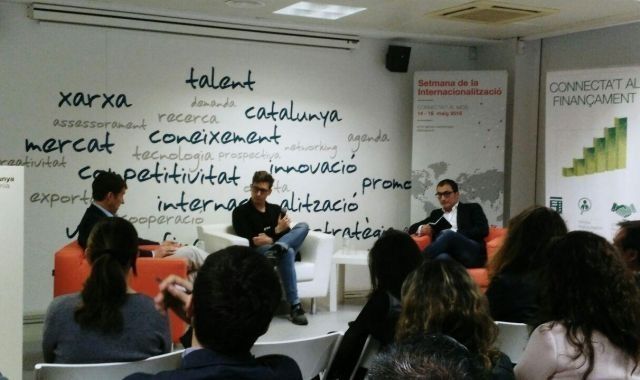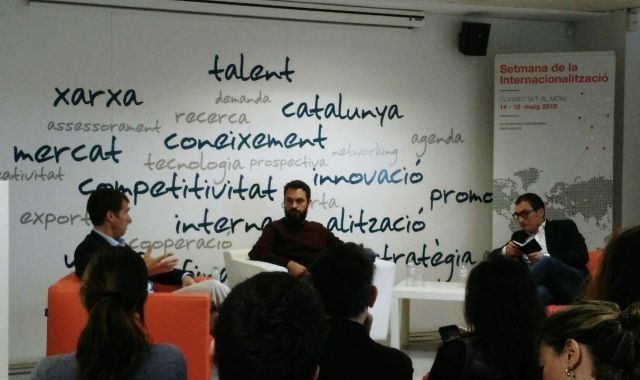
From San Francisco to San José is a region that features in the dreams of many an entrepreneur and company around the world. We are talking about Silicon Valley, the home of Google, Facebook and WhatsApp, but also HP. Some 25% of its businesses are technological and it boasts 50% of the venture capital in the United States and over 2,000 investors. All of this makes it the American dream for companies, whether startups that are global from the beginning or organisations looking to expand their success beyond Catalonia.
Establishing oneself there, though, is not easy. It is a place with lots of opportunities and also a lot of competition. Attractive and frightening, this is the overview of Silicon Valley that came out of a debate organised by the Acció agency as part of Internacionalization Week.
Not for everyone
If there is someone who knows that North America is not for everyone, it is Lluís Gutiérrez. He is a venture capital investor established halfway between Barcelona and Silicon Valley, who one day saw that a path must be opened up to allow Catalan and Spanish investors access to North American companies. “The Americans raise their own funds, they do not come looking for capital in Europe because there they have enough there,” he says, “we thought that this shouldn’t be the case and that investors from here should be able to reach there.”
Gutiérrez: “The Americans raise their own funds, they do not come looking for capital in Europe because there they have enough there”
He heads the investment firm, Telegraph Capital Hill, which specialises in seed funding for software companies focused on B2B, going from 100,000 dollars to half a million, with a maximum of 1.5 million for companies over a number funding rounds. “We have been part of 22 companies that have accounted for some 45 or 50 funding rounds between them. Many have died off, which is to be expected, and others have been bought up. We now have some 12 companies valued at 500 million dollars, when they were worth no more than 10 million dollars when we bought them,” he says. Success can be achieved, but it isn’t easy.
His first premise is that Silicon Valley is not for every company. “There are three reasons why an organisation might think about going there: to access a much larger market, for talent and for capital,” Gutiérrez points out. If these three points are not met, better to stay where you are. It is an idea shared by Albert Colmenero, the COO of Kompyte, real time competitor analysis software that has 90% of its partners, investors and turnover in the US.

Lluís Gutiérrez and Albert Comenero during their talk | A. Corón
They have no office in Silicon Valley, nor are they considering getting one. “We go there often, but we don’t think about setting up there because it is extremely expensive and it is really hard to find talent. There is a lot of talent, but also a lot of companies offering better conditions than a startup,” he points out, which is why they are thinking more about Austin as a potential city to take their next step.
Their history began almost four years ago and they committed, according to Colmenero, “the main mistake of Catalan entrepreneurs”: “Beginning to sell here just because I am from here. We came to see that Spain is not the best country to sell innovative technology, so we quickly started going abroad.” Since then they have worked out of Barcelona, where there is a team working “on North American time, that speaks fluent English, that knows how to sell, and that has low salaries with high commission,” something that he says is not sustainable. The company is now considering taking the next step, but it is doing so very carefully after having validated the model and in the knowledge that there are cities that are much more suitable than Silicon Valley.
Being there at the right time
The Channer Mobile TV first appeared before the iPhone. It is an app for watching and interacting in real time with television on a mobile phone that was developed by the entrepreneur Nina Alstruey, who knew from the outset that it was time to fulfil the American dream of going to the United States. “Each startup and area has an ideal market to break into. Silicon Valley is very receptive to innovation and we knew that we had to go there. Google had not long bought YouTube and I had the feeling that we were arriving late, but we had to go because setting up a technology company here is not feasible. There is not enough capital and people are not receptive,” she says.
In a short time, and after making the application suitable for all operating systems, some 50% of their users were from the US, which validated her choice. However, it is a strategy that is very different to the one currently being carried out with Motovoy. This new project consists of creating the first network for express motorbike repairs available from a mobile. It has premises in Barcelona with capacity for 20 vehicles and with a service apt for B2B and B2C.
Alastruey: "Not everyone should go to Silicon Valley"
In this case, they decided to stay here to launch the idea because, as she points out, “Barcelona has more motorbikes than Silicon Valley. It is the city with the most motorbikes per inhabitant in Europe.” “It will work here, but not in the United States. That’s why must see that not everyone has to go there,” she insists.
The best talent is also found at home
Everything that comes out of the US is good. For the CEO and cofounder of Plazah, Roger Casals, this a myth, “a myth that must be done away with because talent comes from all over in a matter of milliseconds.”
Casals: “Everyone has experience of Facebook and Google, but if you don’t work there and you are available, it is because you are not good"
Casals has more than 20 years experience in launching startups on both a domestic and international level, which means he knows firsthand what it means to find qualified professionals. “Everyone has experience of Facebook and Google, but if you don’t work there and you are available, it is because you are not good. Don’t take anyone on there,” he recommends, “it is also four times more expensive to take someone on, you won’t be able to keep on paying 250,000 dollars a year to someone under 30.” So, looking for talent should never be the motive for going international.
Another way of doing things
Mapfre, Repsol, Santalucía... They are just three examples that Casals mentions of companies he has worked with while doing business in Spain, companies that he could still be waiting to hear from. “Business is very slow. I have been waiting 10 years for some companies to tell me no, they like to drag everything out, saying they’ll get back to you in a few months, when there is a budget,” he says by way of example. “In the US it’s seen as more polite to say that you are not a good fit,” he says, pointing to one key difference. “At the start it depresses you, but you keep going, and you see that it is in Spain where it is truly hard to sell software.”
Another feature of the North American market is highlighted by the founder and CEO of Factorial, Jordi Romero, who saw the American way of doing things firsthand with the Teambox software. “Soon after going to San Francisco we already had 40% of our clients there, which showed that you do not have to physically be there because our HQ continued to be in Barcelona,” he says.

Jordi Romero during his talk | A. Corón
The main lesson learnt was that you cannot go over there with the same structure that works in Spain. According to the executive, raising capital was more difficult because there was no investor with experience in software as a service and, when they found a possible candidate, “being a limited company and being funded by friends, family and others did not help.”
The advice they were given was to go home and replicate the model, something they hadn’t tried. And so that is what they did, choosing to keep a development office in Barcelona, paying a third of the cost of the professionals in Silicon Valley, and with a CEO and a sales team in the US. Now, with a more solid business, taking a firm step towards North America was a more feasible option.